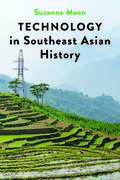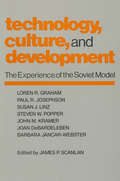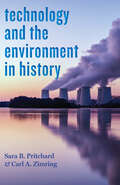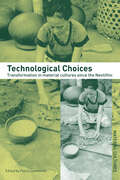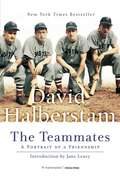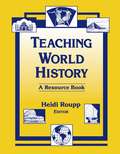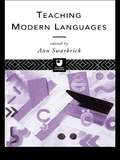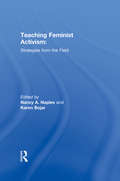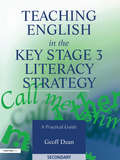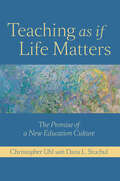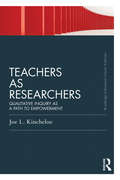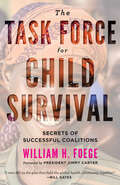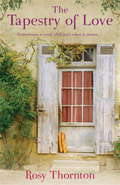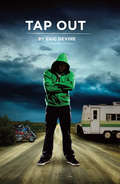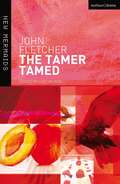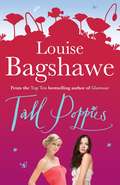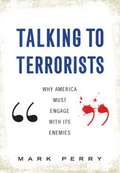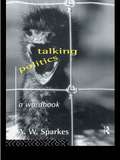- Table View
- List View
Teens Together Grief Support Group Curriculum: Adolescence Edition: Grades 7-12
by Linda Lehmann Shane R. Jimerson Ann GaaschThe texts focus on preschool-aged children, children in kindergarten through grade two, children in grades three through six, and teenagers.Each curriculum contains ten ninety-minute sessions that should be implemented over a period of ten weeks. By employing age-appropriate themes to engage the child and provide continuity throughout the sessions, the division of material within the curricula assures that the activities reflect the developmental level of the grieving child or adolescent. Each person grieves differently, and Grief Support Group Curriculum addresses the issues related to mourning while recognizing the importance of individuality in grieving.
Technology, Culture and Development: The Experience of the Soviet Model
by James P. ScanlanAlthough scholars have devoted much attention to the impact of technology on society, they have tended to slight the question of how technology is affected by social systems. The authors of this volume take precisely this approach in their examination of the "Soviet model" of development. The book surveys the history and current state of science and technology in the USSR and its former satellites. It then looks at the economic environment for technological innovation and examines the impact of the "energy shock" in the transitional economies of the region. Finally, it discusses the ecological devastation of the USSR and Eastern Europe, its connection with the "Soviet model" and the prospects for remediation. The central argument of the book is that the cultural and social factors and the legacy of the Soviet model will inevitable figure in the reconstruction of the East.
Technology and the Environment in History: Nature and Technology in History (Technology in Motion)
by Sara B. Pritchard Carl A. ZimringToday's scientists, policymakers, and citizens are all confronted by numerous dilemmas at the nexus of technology and the environment. Every day seems to bring new worries about the dangers posed by carcinogens, "superbugs," energy crises, invasive species, genetically modified organisms, groundwater contamination, failing infrastructure, and other troubling issues. In Technology and the Environment in History, Sara B. Pritchard and Carl A. Zimring adopt an analytical approach to explore current research at the intersection of environmental history and the history of technology—an emerging field known as envirotech. Technology and the Environment in History They discuss the important topics, historical processes, and scholarly concerns that have emerged from recent work in thinking about envirotech. Each chapter focuses on a different urgent topic: • Food and Food Systems: How humans have manipulated organisms and ecosystems to produce nutrients for societies throughout history.• Industrialization: How environmental processes have constrained industrialization and required shifts in the relationships between human and nonhuman nature.• Discards: What we can learn from the multifaceted forms, complex histories, and unexpected possibilities of waste.• Disasters: How disaster, which the authors argue is common in the industrialized world, exposes the fallacy of tidy divisions among nature, technology, and society.• Body: How bodies reveal the porous boundaries among technology, the environment, and the human.• Sensescapes: How environmental and technological change have reshaped humans' (and potentially nonhumans') sensory experiences over time.Using five concepts to understand the historical relationships between technology and the environment—porosity, systems, hybridity, biopolitics, and environmental justice—Pritchard and Zimring propose a chronology of key processes, moments, and periodization in the history of technology and the environment. Ultimately, they assert, envirotechnical perspectives help us engage with the surrounding world in ways that are, we hope, more sustainable and just for both humanity and the planet. Aimed at students and scholars new to environmental history, the history of technology, and their nexus, this impressive synthesis looks outward and forward—identifying promising areas in more formative stages of intellectual development and current synergies with related areas that have emerged in the past few years, including environmental anthropology, discard studies, and posthumanism.
Technology and the Environment in History: Nature and Technology in History (Technology in Motion)
by Sara B. Pritchard Carl A. ZimringToday's scientists, policymakers, and citizens are all confronted by numerous dilemmas at the nexus of technology and the environment. Every day seems to bring new worries about the dangers posed by carcinogens, "superbugs," energy crises, invasive species, genetically modified organisms, groundwater contamination, failing infrastructure, and other troubling issues. In Technology and the Environment in History, Sara B. Pritchard and Carl A. Zimring adopt an analytical approach to explore current research at the intersection of environmental history and the history of technology—an emerging field known as envirotech. Technology and the Environment in History They discuss the important topics, historical processes, and scholarly concerns that have emerged from recent work in thinking about envirotech. Each chapter focuses on a different urgent topic: • Food and Food Systems: How humans have manipulated organisms and ecosystems to produce nutrients for societies throughout history.• Industrialization: How environmental processes have constrained industrialization and required shifts in the relationships between human and nonhuman nature.• Discards: What we can learn from the multifaceted forms, complex histories, and unexpected possibilities of waste.• Disasters: How disaster, which the authors argue is common in the industrialized world, exposes the fallacy of tidy divisions among nature, technology, and society.• Body: How bodies reveal the porous boundaries among technology, the environment, and the human.• Sensescapes: How environmental and technological change have reshaped humans' (and potentially nonhumans') sensory experiences over time.Using five concepts to understand the historical relationships between technology and the environment—porosity, systems, hybridity, biopolitics, and environmental justice—Pritchard and Zimring propose a chronology of key processes, moments, and periodization in the history of technology and the environment. Ultimately, they assert, envirotechnical perspectives help us engage with the surrounding world in ways that are, we hope, more sustainable and just for both humanity and the planet. Aimed at students and scholars new to environmental history, the history of technology, and their nexus, this impressive synthesis looks outward and forward—identifying promising areas in more formative stages of intellectual development and current synergies with related areas that have emerged in the past few years, including environmental anthropology, discard studies, and posthumanism.
Technological Choices: Transformation in Material Cultures Since the Neolithic (Material Cultures)
by Pierre LemonnierFirst published in 1993. Routledge is an imprint of Taylor & Francis, an informa company.
Technological Change: Methods and Themes in the History of Technology (Routledge Studies in the History of Science, Technology and Medicine #Vol. 1)
by Robert FoxIn this volume, scholars from these two very different traditions are brought together. Never before has a single volume contained such a distinguished and diverse group of historians of technology.
The Teammates: A Portrait of a Friendship
by David HalberstamMore than 6 years after his death David Halberstam remains one of this country's most respected journalists and revered authorities on American life and history in the years since WWII. A Pulitzer Prize-winner for his ground-breaking reporting on the Vietnam War, Halberstam wrote more than 20 books, almost all of them bestsellers. His work has stood the test of time and has become the standard by which all journalists measure themselves.The Teammates is the profoundly moving story of four great baseball players who have made the passage from sports icons--when they were young and seemingly indestructible--to men dealing with the vulnerabilities of growing older. At the core of the book is the friendship of these four very different men--Boston Red Sox teammates Bobby Doerr, Dominic DiMaggio, Johnny Pesky, and Ted Williams--who remained close for more than sixty years.The book starts out in early October 2001, when Dominic DiMaggio and Johnny Pesky begin a 1,300-mile trip by car to visit their beloved friend Ted Williams, whom they know is dying. Bobby Doerr, the fourth member of this close group--"my guys," Williams used to call them--is unable to join them.This is a book--filled with historical details and first-hand accounts--about baseball and about something more: the richness of friendship.
Teaching World History: A Resource Book (Sources And Studies In World History Ser.)
by Heidi RouppA resource book for teachers of world history at all levels. The text contains individual sections on art, gender, religion, philosophy, literature, trade and technology. Lesson plans, reading and multi-media recommendations and suggestions for classroom activities are also provided.
Teaching Modern Languages: Perspectives On Practice (Open University Ser.)
by Ann SwarbrickModern language classrooms are currently dominated by the communicative method of language teaching. This reader draws together recent and newly commissioned papers to show the origins of communicative methodology, how it has developed, what its research justification is and how it can most effectively be used in the classroom. Various chapters examine the particular challenges of differentiation, teaching grammar, encouraging pupils to use the target language together and teaching a foreign language to children with special educational needs. The final section discusses ways of developing creativity in the modern languages classroom through the use of drama, creative writing and role play. Anyone involved in teaching modern languages will find this reader a rich source for reflection and good practice.
Teaching Malcolm X: Popular Culture and Literacy
by Theresa PerryThe volume brings together a dazzling array of perspectives on Malcolm X to discuss the importance of X as a cultural hero and provide guidelines for teaching Malcolm-related material at elementary, high school and university levels.
Teaching Feminist Activism: Strategies from the Field
by Nancy A. Naples Karen BojarFrom theoretical analysis to practical teaching tools, an indispensable guide for educators seeking to link feminist theory and activism to their teaching. Included are web sites, videos, recommended texts, and additional course outlines.
Teaching English in the Key Stage 3 Literacy Strategy
by Geoff DeanThis book will supplement the training currently being offered to all secondary English departments. It offers a view of the place of the English 'strand' in the overall Key Stage 3 strategy and gives support to English departments in their preparations for a new way of working. It will encourage English teachers to review their current schemes of work, offering suggestions for more substantial teaching and learning modules, as well as practical ideas for classroom use and recommended resources. The book interprets and explains the NLS document for busy practitioners; reinforces the messages of the National Literacy Strategy (NLS); spells out the expectations of the framework and offer guidance on how to fulfil them; and describes and explains the types of teaching methods to improve students' learning. This book includes many practical ideas for classroom activities and offers direct support for the less confident English teacher. The book is equally valuable to students and practicing teachers.
Teaching as if Life Matters: The Promise of a New Education Culture
by Christopher UhlWhat would it be like to teach as if life matters? To move beyond the typical regimen of classroom exercises, homework, and standardized tests and to guide students through life’s most important lessons? Dissatisfied with traditional educational models, Christopher Uhl and Dana L. Stuchul asked themselves these questions. What they discovered will open the eyes of today’s educators to a whole new way of teaching.The authors promote an approach that fosters self-knowledge, creativity, curiosity, and an appreciation for our planet. Central to their philosophy is the question of what we humans need in order to live meaningful lives. The answer: healthy relationships with ourselves, each other, and the world. Teaching as if Life Matters is an open letter to teachers offering guidance and encouragement for nurturing students in ways that make teaching and learning meaningful. In short, it is a passionate plea for transformative teaching. Informed by the alternative educational philosophies of John Dewey, Maria Montessori, Rudolf Steiner, and Ivan Illich, this book invites teachers and students to participate in a new culture of education.This fascinating and urgently needed book will inspire today’s educators to inspire their students.
Teaching and Learning in Further Education: Diversity and change
by Prue Huddleston Lorna UnwinTeaching and Learning in Further Education is established as an authoritative, wide-ranging introductory text for those training to work in the further education, post-compulsory education and lifelong learning sectors. It offers an easy to read picture of the practitioner’s everyday working life, a thorough historical account of the FE context and excellent advice on how to improve practice and enhance professional development. Essential topics covered include: Key theorists Teaching strategies Assessment issues The diverse curriculum The nature of the student body Blended learning and virtual learning E-assessment and personal records of achievement The fourth edition will be significantly updated in light of the latest research into teaching and learning, as well as extensive changes in the field including: Revision to the professional standards for teachers, tutors and trainers in the lifelong learning sector; increased provision of HE in FE; the introduction of functional skills and the 14-19 Diploma and the shifting nature of vocational qualifications. Illustrated throughout by case studies and vignettes, and supported by reflective actitities and references to well respected research and literature, Teaching and Learning in Further Education is an essential text to be used throughout an FE tutor’s journey from trainee to qualified lecturer.
Teachers as Researchers: Qualitative inquiry as a path to empowerment (Teachers' Library)
by Joe L KincheloeTeachers as Researchers urges teachers - as both producers and consumers of knowledge - to engage in the debate about educational research by undertaking meaningful research themselves. Teachers are being encouraged to carry out research in order to improve their effectiveness in the classroom, but this book suggests that they also reflect on and challenge the reductionist and technicist methods that promote a 'top down' system of education. It argues that only by engaging in complex, critical research will teachers rediscover their professional status, empower their practice in the classroom and improve the quality of education for their pupils. Now re-released to introduce this classic guide for teachers, the new edition of Teachers as Researchers now also includes an introductory chapter by Shirley R. Steinberg that sets the book within the context of both the subject and the historical perspective. In addition, she also provides information on some key writing that extends the bibliography of this influential book thereby bringing the material fully up to date with current research. Postgraduate students of education and experienced teachers will find much to inspire and encourage them in this definitive book.
The Task Force for Child Survival: Secrets of Successful Coalitions
by William W. FoegeDr. Bill Foege, one of the best-known names in global health, brings readers to the table during the creation of one of the world;€™s most famous and successful global health efforts;¢;‚¬;€?the Task Force for Child Survival.In 1984, the US immunization program was so successful that many childhood diseases were at record lows;¢;‚¬;€?yet 40,000 children a day were dying around the world from preventable diseases. That year, Dr. Foege, former director of the Centers for Disease Control and Prevention, came together with Jonas Salk, Robert McNamara, and representatives from UNICEF, the World Health Organization, the World Bank, the United Nations Development Programme, and the Rockefeller Foundation to see how some of the lessons learned in America could be applied to global programs. The assembled participants recommended the formation of a small task force to help UN agencies improve immunization coverage. They dubbed it the Task Force for Child Survival and installed Foege as its first leader.In this book, Dr. Foege describes the task force from its conception through its landmark success. Over its first six years, as more resources were allocated to the task force, immunization coverage climbed from approximately 15 percent of the world;€™s children for some vaccines to 80 percent of the world;€™s children for at least one vaccine. UNICEF head Jim Grant called it the greatest peacetime endeavor the world had ever seen. How did this small, independent, low-profile group leverage change in the largest of global health agencies? Foege dissects each element for clues as to why the task force was able to accomplish so much so quickly, ultimately concluding that coalition-building played a major role and explaining how to strengthen coalitions by scrupulously avoiding the turf guarding and credit seeking that are so common to international endeavors.Inspiring and accessible, this brief book combines the distilled advice of one of global health's major leaders with the history of an iconic public health program.
The Task Force for Child Survival: Secrets of Successful Coalitions
by William W. FoegeDr. Bill Foege, one of the best-known names in global health, brings readers to the table during the creation of one of the world;€™s most famous and successful global health efforts;¢;‚¬;€?the Task Force for Child Survival.In 1984, the US immunization program was so successful that many childhood diseases were at record lows;¢;‚¬;€?yet 40,000 children a day were dying around the world from preventable diseases. That year, Dr. Foege, former director of the Centers for Disease Control and Prevention, came together with Jonas Salk, Robert McNamara, and representatives from UNICEF, the World Health Organization, the World Bank, the United Nations Development Programme, and the Rockefeller Foundation to see how some of the lessons learned in America could be applied to global programs. The assembled participants recommended the formation of a small task force to help UN agencies improve immunization coverage. They dubbed it the Task Force for Child Survival and installed Foege as its first leader.In this book, Dr. Foege describes the task force from its conception through its landmark success. Over its first six years, as more resources were allocated to the task force, immunization coverage climbed from approximately 15 percent of the world;€™s children for some vaccines to 80 percent of the world;€™s children for at least one vaccine. UNICEF head Jim Grant called it the greatest peacetime endeavor the world had ever seen. How did this small, independent, low-profile group leverage change in the largest of global health agencies? Foege dissects each element for clues as to why the task force was able to accomplish so much so quickly, ultimately concluding that coalition-building played a major role and explaining how to strengthen coalitions by scrupulously avoiding the turf guarding and credit seeking that are so common to international endeavors.Inspiring and accessible, this brief book combines the distilled advice of one of global health's major leaders with the history of an iconic public health program.
The Tapestry of Love
by Rosy ThorntonA warm and uplifting story of how a woman falls in love with a place and its people: a landscape, a community and a fragile way of life. A rural idyll: that's what Catherine is seeking when she sells her house in England and moves to a tiny hamlet in the Cévennes mountains. With her divorce in the past and her children grown, she is free to make a new start, and her dream is to set up in business as a seamstress. But this is a harsh and lonely place when you're no longer just here on holiday. There is French bureaucracy to contend with, not to mention the mountain weather, and the reserve of her neighbours, including the intriguing Patrick Castagnol. And that's before the arrival of Catherine's sister, Bryony...
Tap Out
by Eric DevineSeventeen-year-old Tony Antioch lives in Pleasant Meadows, a trailer park where questions aren't asked since everyone already knows the answers from their own experience. He dreams of rescuing his mother from her constant stream of abusive boyfriends but in reality can barely duck the punches that are aimed at himself.When Tony is coerced into joining his friend Rob's Mixed Martial Arts class, he is surprised to find that he has a talent that he actually wants to develop. But with a meth-dealing biker gang that is hungry for recruits and a vicious cycle of poverty and violence that precedes him, Tony is going to need a lot more than blood and guts to find a way out.Gritty, powerful, and unapologetic, Tap Out explores what it takes to stay true to oneself and the consequences of the choices made along the way in order to do so.
The Tamer Tamed: Or, The Tamer Tamed (New Mermaids)
by John Fletcher Lucy MunroThe Tamer Tamed is the subtitle or alternative title to John Fletcher's The Woman's Prize, a comedic sequel and reply to The Taming of the Shrew.The plot switches the gender roles of Shakespeare's play: the women seek to tame the men. Katherine (the "shrew" of the original) has died, and Petruchio takes a second wife, Maria. Maria denounces her former mildness and vows not to sleep with Petruchio until she "turn him and bend him as [she] list, and mold him into a babe again." After many comedic exchanges and plot twists, Petruchio is finally "tamed" in the eyes of Maria, and the play ends with the two reconciled. The play is seen to reflect how society's views of women, femininity, and "domestic propriety" were beginning to change. It is said that Fletcher wrote this play to attract Shakespeare's attention - the two went on to collaborate on at least three plays together. This brand new New Mermaid edition offers unique and fresh insight into the critical interpretation of the play. It builds on current critical foundations (the relationship with Taming of the Shrew, gender relations etc) and suggests different areas of interest (popular associations of the shrew, the question of reputation, and a re-examination of the play's structure). as well as examining stage history and recent productions.
Tall Poppies: Career Girls, The Movie, Tall Poppies (Isis Cassettes Ser.)
by Louise BagshaweWith her public school education, trust fund and castle for a family home, Elizabeth Savage has seemingly led a privileged life. But the one thing she really wants, the chance to prove herself in the world of work, is the one thing she can’t get. New Yorker Nina Roth, on the other hand, was born the wrong side of the tracks, and it’s sheer grit and determination that have made her the successful career woman she is. Set on making a better life for herself, she’s done what needed to be done. But has she gone one step too far? Two women from two different worlds, but these tall poppies have much more in common than they think. And, as both will find, the trouble with being a tall poppy is people will try and cut you down to size...
Talking to Terrorists: Why America Must Engage with its Enemies
by Mark PerryIt has long been an article of faith that the United States does not "talk to terrorists”-that to engage in dialogue with groups such as Hamas, Hezbollah, and the Muslim Brotherhood would be tacitly to acknowledge their status as legitimate political actors. Not so, argues Middle East expert Mark Perry. In the absence of dialogue, we have lumped these groups together with Al Qaeda as part of a monolithic enemy defined by a visceral hatred of American values. In reality, while they hold deep grievances about specific US policies, they are ultimately far more defined by their opposition to the deliberately anti-political Salafist ideology of Al Qaeda.Drawing on extensive interviews with Washington insiders, Perry describes fruitful covert meetings between members of the US armed forces and leaders of the Iraqi insurgency to demonstrate that talking to terrorists may be best way to end terrorism-controversial wisdom we ignore at our peril.
Talking Politics: A Wordbook
by A. W. SparkesTalking Politics is a philosophical examination of some of the basic concepts of political discourse. Its primary focus is on the ordinary; on what is said by politicians, in newspapers and by people in pubs, rather than on the works of political theorists. This is a work of, but not on political theory.Talking Politics is:* Invaluable as a source of reference for students, and contains a detailed index* Arranged thematically, around topics such as `Nation'. Each entry has copious cross-references and suggestions for further readingA. W. Sparkes is uniquely qualified to write such a book, combining some thirty years' teaching as a philosopher with wide experience of, and a life-long fascination with, politics. His attitude is that of a critical, but uncynical, observer.

